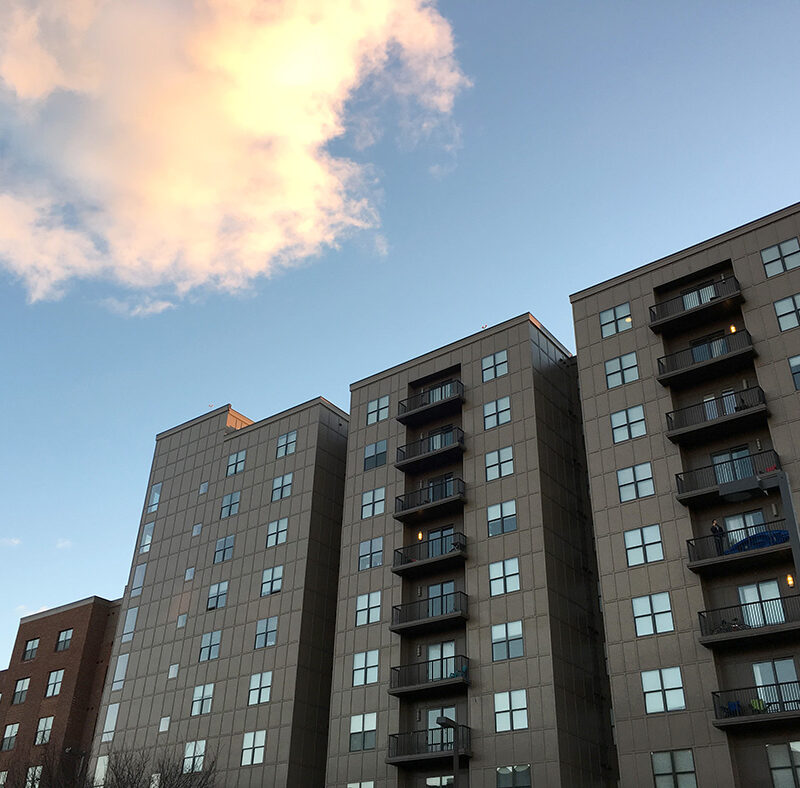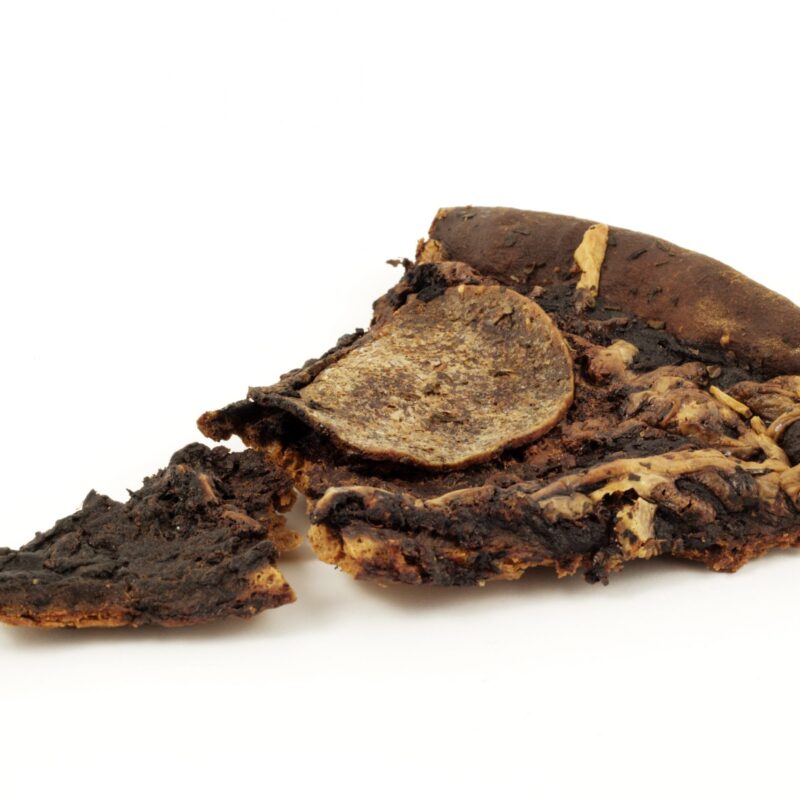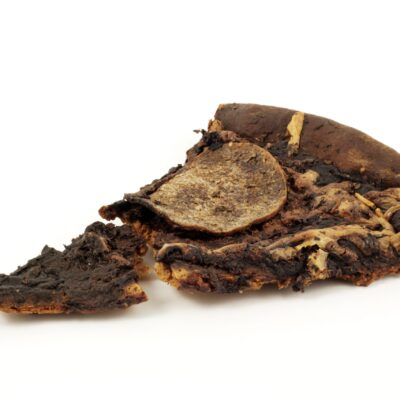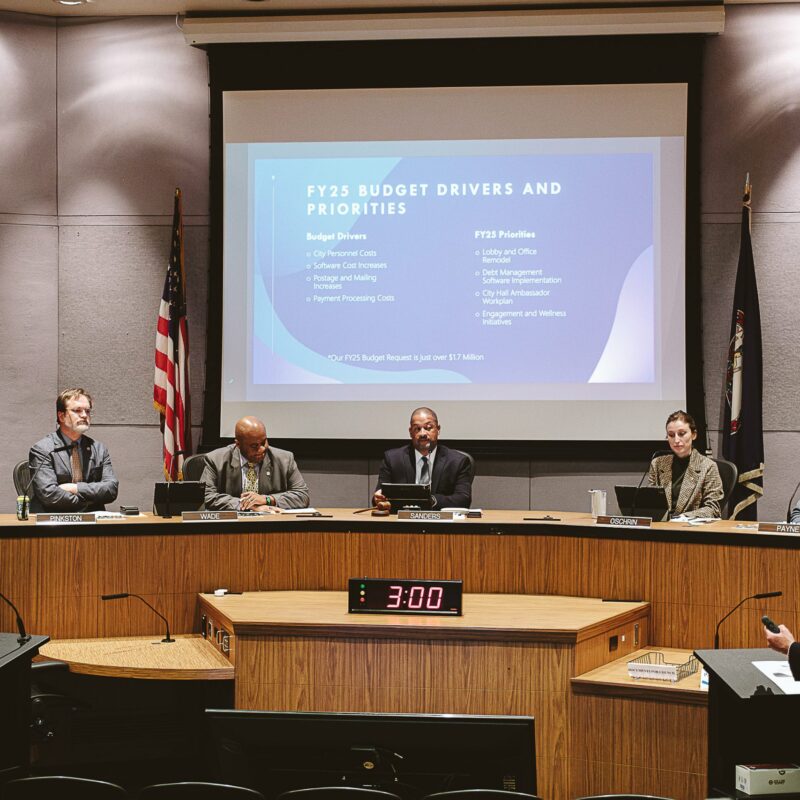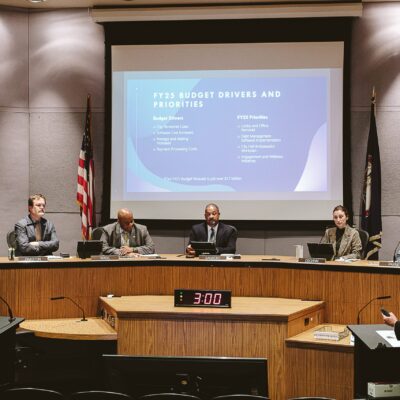|
VIDEO BY COOGAN BRENNAN |
In Richard Crozier’s studio behind his Preston Place home, about 1,000 of his original works line shelves and baskets on the floor. You could find a football field, lay them all out, and spend hours looking at an impressionistic map of Charlottesville, composed entirely of the many moments Crozier spent brush in hand. Crozier (whose work is on view at UVA’s Ruffin Gallery through January 28) retires from UVA this year after 36 years. He has watched the university change from a place where students studied art to satisfy requirements, to a place where students go out of their way to study art. Meanwhile, Crozier encouraged students to channel their energy into painting, rather than thinking about whether something is worth painting. That was the conceit that turned his former student Edward Thomas from an architecture student into a landscape artist, also of the plein air variety, and where their conversation began last month.
Edward Thomas: So Dick, I see that this week you painted the ruins of the burnt out Taco Bell on 29.
Richard Crozier: Yeah. Anything that’s kind of like an event is interesting to me. Some of the events are sad, destructive and so forth; I painted a church that burned down in Ruckersville recently. I hope people don’t start noting my proximity to burnt buildings and start asking questions.
Why do you paint outdoors rather than in a studio?
I have to be in front of what I’m painting. You see people working from photographs a lot, but you get to a point where you hit a wall with a photograph, and there’s no more information you can get out of it. When you’re sitting in front of the thing you’re painting, you pick up a lot of information over a period of time. Your ideas are changing, and you’re finding stuff you didn’t know was there. You start connecting the information you’re seeing with things in your own history, and it becomes more of a meditation on the subject.
When you paint outdoors I know you tend to paint within your car.
I like painting from the car because you’re a little more out of sight. Kind of like the ostrich with its head in the sand. You think nobody can see you when you’re sitting in the car. That’s not true, of course. You’re out of the weather, you can get in and out of places fairly quickly, which is sort of nice. And it’s comfortable.
I’ve seen paintings from parking lots where it looks like after you started painting, someone parked a giant SUV in front of you.
It happens.
Rather than giving up, or coming back the next day, you paint the giant SUV filling up the rest of the painting.
That’s real life, you know? Sometimes people pull in and you look at them and think, “They’ll be here 15 minutes and then they’ll go.” Sometimes they do. Other times you end up with that in your windshield. You have to accept it. I guess it’s part of the rules I make for myself.
|
Richard Crozier (left) and Edward Thomas are pictured in Crozier’s backyard studio on Preston Place. While a student at UVA, Thomas learned from Crozier to spend less time thinking about what to paint, and more time painting. Both are now plein air painters. |
Over the years you must have had a lot of encounters with curious people, or law enforcement or security guards wondering what you’re doing. Do any particular stories come to mind?
I was painting that site where Hydraulic Road and Route 29 cross, where they’re going to put in that shopping center. They took out a couple buildings a few years back, and trees started to come up in the remains of what had been the parking lot. I think it’s really interesting. I like seeing how nature comes back in those situations.
I parked my car across Hydraulic, ran across the road to buy stuff, and since I wasn’t able to get in there with my car I had to stand. Somebody was passed out behind the 7-Eleven, and so I said, “Well, I couldn’t stand right next to this guy.” So I moved over by the woods, and saw that they were full of tarps and mattresses. This guy came out of the woods and said, “Hi there, my name’s Phil. What’s your name?” We chatted for a while, and he told me about how this whole area’s going to change—how it’s going to be a shopping center. I said, “Well, yeah. That’s exactly right. That’s why I want to make a painting of it.” He gave me this funny look and said, “Why the hell wouldn’t you use a camera?” I thought a minute and said, “Well, good question.”
Have you ever been kicked off a property you were painting on?
I got thrown off a graveyard because someone thought I was being disrespectful to the dead. People will come up and want to know what you’re doing, and when they find out they’ll say, “Oh, well, all right. If that’s all you’re doing, that’s O.K.” That’s the one time I can remember being thrown out.
Let’s talk about the early influences on your art—all the way back to your growing up in Hawaii. Did the landscape and culture influence you?
There was a painter of some note who had grown up in the same town that I did, who was born in the middle of the 19th century, went off to France and studied at one of the academies there, and went back to Hawaii and spent the rest of his time painting there. His name was David Howard Hitchcock—or D. Howard Hitchcock. He died before I was born, but my father knew him slightly. His pictures were all of the town and the library and the hotel. What it said to me was that the things around you, things you’re very familiar with, can be important. You can put a gold frame around it and it looks like art. I very much wanted to do that kind of painting.
|
"Art lives by chance, and anything you can do to help it out and save a few pieces is good." |
You mean what some people term the Ashcan School.
He was really more a kind of Impressionist.
But he was painting ordinary things?
The way the land looked. He also had a thing for volcanoes. I guess maybe the burned down Taco Bells are the closest I can get to a volcano around here.
How did your family get to Hawaii?
My folks went over there in the early ’30s as a result of the Depression. My father was from Oregon and my mother was from Idaho. I had an aunt that taught school over there, so they were fairly settled into the community when I was born. I was there until I was 17 and went off to college.
Did you ever try surfing big waves?
Never surfed.
Where did you go to college?
University of Washington—Seattle. This was in the early 1960s at a time when Seattle billed itself as the cultural dustbin of America, which is probably no longer the case. It probably wasn’t then either, but you were a long ways from any major museums.
Aside from Hitchcock’s everyday scenes, was that your first exposure to art and painting?
Pretty much. There was something of an art scene in Hawaii then, but it leaned hard on what happened in California. So there was exposure to contemporary art in a diluted form. My parents were conservative and the notion of abstract painting was something they didn’t approve of. Whenever we saw an art show and there were abstract paintings, they said, “We hope you never do anything like that.” Of course, that made me want to do it. So I spent some time at the University of Washington doing abstract painting.
What were you majoring in at the University of Washington?
My parents had this mistaken idea that I had an aptitude for sciences, which I certainly didn’t, and I went into a pre-dental program. Thank heavens I flunked out of that in very short order and disabused them of any notions they had about my scientific aptitude.
So then you ended up at UC Davis to study art.
I got a Bachelor of Fine Arts degree at the University of Washington and immediately thereafter was drafted. I went to Korea for about two years. And I think my life was probably saved because I think they routinely put art students into the infantry, and they didn’t think I was an art student. This was in the late ’60s, and I did zero art for two years.
/_RDP3359.jpg) |
They put art students into the infantry?
Of course. To get rid of ‘em. They asked me what my degree was in and I mumbled something about Bachelor of Fine Arts. A long time later I saw my army records and they had me down for a Bachelor of Finance. That probably kept me out of the infantry.
What were your contemporaries at Davis painting when you were there?
We had all kinds of things. A couple people did a photo-realist painting, which was very much in vogue at the time. There were a couple people who were conceptual artists, and a couple people who did hard-edge painting. I think I was probably the only realist painter. I started going outside and painting when I was there, which was vastly amusing for the faculty.
Did someone encourage you to do that? A faculty member?
Not really. One of the people on the faculty was named Thiebaud, who is a very well known realist painter. He was sympathetic to people who wanted to do it.
Wayne Thiebaud is famous to most people for painting pastries, cake counters…
A couple of them appeared on The New Yorker’s covers recently. He’s 90 years old and still working hard.
I remember an anecdote you told me about his classes. He would do little demonstration paintings and then lock them up, and they were so valuable that people would try to steal them.
He would do paintings for the class and then wipe them off at the end. The faculty had these storage lockers in the basement, and his was packed with paintings. People would supposedly go in with a stick and knock one over and pull it out, make off with it. I don’t know if that’s true or not, but it wouldn’t surprise me.
You’ve always had articles and postcards pinned to your door for people walking by. When I was at your office at Ruffin Hall last week, I read the Times article about Thiebaud. One of his students talked about the first day of classes. Rather than talking about painting, Thiebaud started listing the best places in town to get the best coffee, the best meats, the best hot dogs. This student was saying that he realized that Thiebaud was giving the ingredients for his paintings. It made me think about my experience under you. We had the most wonderful espresso before we started this interview, which you’ve always pushed on visitors, and wonderful cakes that [Crozier’s wife] Marjorie makes and fine things in your house, with fine ingredients. Do you want to talk about your theories of living well, eating well, shopping well and how that relates to paintings?
I think both Marjorie and I remember our student days as lots and lots of beans and oatmeal, too. This is one way to put that behind you, to enjoy some things that hopefully are harmless pleasures. I’ve always found it very helpful to have art by other people around me.
You’re a renowned collector, and an expert on art and design and antiques. I think a lot of people know you as a painter. I don’t think they realize your depth of knowledge on just about anything that one could find in a junk store or an antique store.
You know, people throw things out they shouldn’t. Every now and again you might see a print or a painting and say, “Well, you know, this was something pretty good, pretty interesting,” and take it home and look at it for a while.
Under stress, people sometimes make bad decisions. I remember going home after my father died and my mother was cleaning out the apartment. There were boxes of things like very nice prints that would go to the Salvation Army. I spent some time probing through the boxes, thinking I’d better hang on to those things. I think that happens a lot. Someone cleans out a house, and you never know what happens. Art lives by chance, and anything you can do to help it out and save a few pieces is good.
I know that you put a lot of care into making your art as archival as possible. Why paint in oil? What are the chances that your paintings will survive 200, 300, 400 years from now?
Mostly I think art survives if somebody likes it enough to take care of it. Even a really terrifically crafted painting that’s kept in the basement or attic too long is going to suffer a lot of damage. Some people are concerned about it, other people are not. You might as well go through the little extra trouble to make sure it’s not going to fall apart in your lifetime. I asked Bill Wiley, who’s another one of those California painters, what he thought about the permanence of painting. He said the best painting he ever did he did on a tortilla.
Some artists put out maybe 10 paintings a year. You, looking around your studio, we see probably, over 1,000 paintings sitting here.
I think, for me, it’s very important to keep the momentum going. When I’m painting on a daily basis I start seeing a lot of stuff I can paint. That keeps that ball rolling. The other thing is there are always paintings that aren’t very good. Of the 100 paintings you might get, only 10 or 20 are keepers for sure.
Someone asked Picasso what was his favorite painting he had done was, and he said, “Tomorrow’s painting.”
Any painting is the sum of many, many destructions. If you get too precious about the work, it gets hard to make those destructions, to change things, to take the chance of ruining something for the chance of making it better.
Frugality. That was something I thought I wanted to bring up with you. Frugality in your work and how it relates to the current state of the art world and the economy. I was reading a review of Jack Boul’s art work, the idea of teeny little paintings that you do, relatively small, and you try to make them relatively inexpensive for people to buy.
Well, I have a bad habit of painting everything either too big or too small, probably, if I talked to the gallery folks about that. A particular thing I observed this morning, I just realized [turning to a four-panel painting of the Rivanna River] I’m going to have to add a panel to that thing. That’s going to be a 12′-long painting. Where the hell am I going to go with a 12′-long painting?
/1146982925_crozier-0019.jpg) |
You’re retiring this month after 36 years of teaching. How did you get to UVA?
When I graduated with an MFA at UC Davis, I assumed I’d push a broom or flip hamburgers, like a lot of people did. I was walking past the chairman’s office and he leaned out the door and said, “Hey Crozier, you want a job?” And it turned out the person who was the chair of the Art Department here was desperate to hire someone because someone had resigned a day or two before classes. The main question was, “Will you get on a plane and come down here sight unseen?” I found myself an art professor very abruptly.
What changes have you seen in the Art Department, the students and trends in the art world in that time?
When I started there in ’74, the Art Department had just gone through a tremendous period of expansion. Women were admitted in ’70. That was a tremendous boost for the Art Department. A lot of our enrollment is female, and it meant the creation and enhancement of a Studio Art major, it meant a lot of demand for classes and so forth. It put a lot of stress on the facilities, like Fayerweather Hall, where we all taught. It was packed. People were painting in the hallways.
We got Brooks Hall in ’76, and that took a lot of the strain off of Fayerweather Hall. We had more studio space and were able to accommodate students better. And then, we now have Ruffin Hall, which is actually a pretty nice facility. We have the space, we have the facilities, we have all the air handling and safety equipment—everything that we lacked. They were teaching silk screening when I first got to Fayerweather Hall with no ventilation, and that’s not good. Photography was taught in what had been the women’s bathroom. It was really pretty bad. And now they have a beautiful dark room space, and printmaking is done properly.
The students told me when I first got there that nobody ever went to UVA to study art. I think that’s changed. People are coming in to actually be an art major here.
One thing I worry about is the onslaught of new media and digital art pushing out oil painting and more traditional mediums.
I think the demand from the students for painting and drawing classes is the strongest it’s ever been. I think that the curious thing is we’re seeing the development of a number of different art worlds that really don’t have much to do with each other. Digital art, new media and conceptual art—these things almost have nothing to do with painting. If you can think up an idea and execute it, you can do that very quickly if you’re a smart person. But if you want to learn how to paint, it will take you years to develop the skills to do it. I think there’s a divergence in the way art is going to have to be taught and how people think about it.
I think of you as a street artist, and myself too, because we paint out on the street. Do you feel an affinity toward graffiti artists and other types of street artists?
I like them very much because it makes the world more interesting. I love graffiti, and I like to paint pictures that have graffiti in them. Again it’s a marker in terms of time and place and what’s going on in the world. But I don’t think we’re doing the same thing at all.
The editor insisted that I ask you. Do you have any stories about me, or do you remember when I first came to you as a student?
I do indeed. It was a painting class where I asked people to do a self-portrait on an unconventional surface. You did a really remarkable picture of yourself reflected in a spoon. It was very painterly, and quite wonderful. It was head-and-shoulders above anything else in the class and I thought, “Who is this guy? And why is he an architect?”
What are you going to do now with all your extra free time?
Make more paintings. Basically, quitting the university, or retiring, is quitting the day job. At last, I can be an artist full time.
/_RDP3336.jpg)
/1146993924_crozier-0056.jpg)
